| San Esteban De Gormaz is a Castilian village located 70 kms east of the capital of the province (Soria), 28 km of Tiermes and 45 km of Aranda de Duero. It is strategically situated between the bank of River Duero and a small hill in which the resemblances of its castle are still alive on the top. The first vestiges date from Neolithic Calcolitic (cave of the Salinas). Some references from the Celtiberic stage also exist, we must highlight their presence in the Roman Age as it is stated by the amount of ruins found: inscriptions, ceramic, decorative and architectonic elements. |
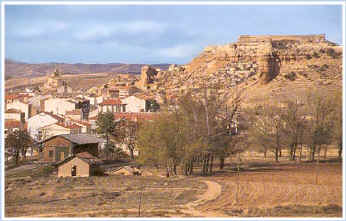 |
Nevertheless, the most important issue of San Esteban de Gormaz in the History of Spain would be carried out by the reconquest.
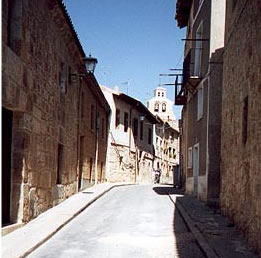 |
In the year 883 king Alfonso III conquered this
territory and refortify it, clarifying the boundary for Muslims and
Christians in the river Duero. In the year 912, Fernando Fernandez
resettled the village. Afterwards S. E. De Gormaz is going to be the
spectator of many battles between the Muslim and the Christian kingdoms,
and the possession of the village is now swayed by both kingdoms,
depending on the sign of the battle. Once finished the reconquest, the villa is dived into a dream that would reflect in a political, economical and demographic delay. The hard climate conditions and the subsequent epidemies shrank its population. In the XX century it would bright on, thanks to the settlement of several factories that would serve as the complement for the numerous agrarious population; being these factories the drawback for the rural exodus to the big town and cities. Nowdays, it possesses a complete infrastructure of all the public works and commercial that guarantee the security and well-served conditions for the nearly 2500 Sanestebeños citizens that live in it. |
Arch of the Villa, Big Square and Big Street
When we enter the square through the road we come across the Arch of the Villa that was the entrance of the ancient wall. On the top, it keeps the scutcheon with the arms of Don Diego I López Pacheco el Grande who was the earl of San Esteban during the years 1501 and 1529.
|
The Big Square is formed by a group of building with "porticos". On the west facade we come across the town-hall which was built recently. This building was constructed to imitate the last one which stoop up proudly at the same point. In the villa from 1629 to 1966. In this year, it was unfortunately substituted by another town-hall as this was more modern and less related with the area. In 1994 the Duchess of Alba, earl of San Esteban inaugurated the current town-hall which gives back the lost splendour to the whole square. |
 |
The "Big Steet" passes through one of the sides of the square and goes on with some galeries with porticos towards the west. Along the street we come across the most illustrious houses in the village: blasonaded stone buildings with scutcheons that belonged to some noble families. We might highlight the so-called "Cuartel Viejo" building (used as the place for the civil defence) in the first half of the century.Apart from the scutcheon, we can appreciate in the facade some Roman tomb-stones and a decorated visigotic stone masonry.
San Miguel Church
The San Miguel Street begins on the right hand side of the Big street. This stoned and narrow street leads us to one of the most noteworthy and surprising buildings of the Romanic Art. It was built in 1081 by the magisterial ingeneer Julianus ( it may be read on the entrance-arch of the portico). This date makes it not only the first Romanic church with porticos in the province, but also one of the pioneers in the whole Romanic of Castilla-Leon.
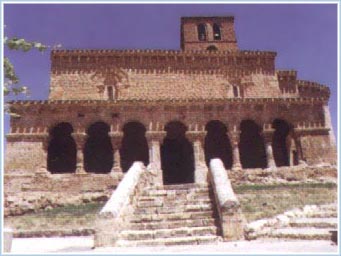 |
Its porticated galery looks on the south and it is constituted by 7 archs above the wall, only disrupted by the central part which serves as the door. The kind of construction is quite easy. It is built with only one aisle with a wooden cover that looks on a semicircular apsis area that locks it. The square tower is leaning next to the building and it belongs to a later age. It was built with stone in the bottom part and with brick on the top part. It is an evidence of the strong Muslim influence which is the predominant note in the rest of the building and, above all, in the decorative elements. |
Church of Nuestra Señora del Rivero
It is the most devoted church in the village on account of many prayers for the Virgen of the Rivero. It is placed up on a boulder. There appears the exceptional sight of all the bank of the Duero (the Virgin takes its name).
|
It was built in the first part of the XII Century and keeps the same style and structure of San Miguel, although it has bigger dimensions. The decorative elements are much more perfect, this is due to the Muslim influence. We must enter the portico through long stairs. On the right side of the door there are 5 half-pointed archs held by long columns and beautiful capital columns, and on the left, there are 3 plain arches that take the place of the original one, which were lost. It is kept into the portico the sepulchral arches of Vidas Pascual, main character of the famous novel of Vado del Cascajar. |
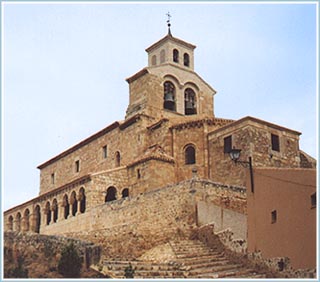 |
In the inner part it is focussed the sober from the XII Century that serves as dwelling for the Virgin of the Rivero and the Chorus with a magnificent-wooden panelled dated in the XVI century. The church lights on its facade a stuck sword from the XVIII century that gives volume and grandeur.
Medieval Bridge
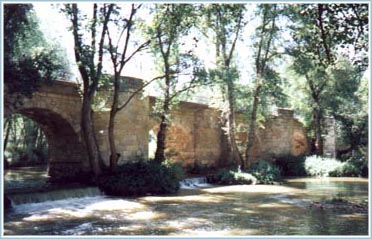 |
The long 16 stone arch bridge that crosses the River Duero is one of the elements that pointed decisively the History of San Esteban de Gormaz. It was one of the few paths that allowed to cross the River Duero in medieval ages, the frontier between the Cristian Reigns and Al-andalus. It may be fundamented in other of Roman origin that, because of its importance, has been repaired, kept and embroaded by the Sanestebeños throughout the centuries once and once more. |
![]()
Translation by DIEGO PÉREZ REDONDO
|
Portal creado por JuaNPa, con la colaboración de Ana Hernando, el Ayuntamiento y los habitantes del municipio de San Esteban de Gormaz
© Copyright 1997-2026 - Queda prohibida la reproducción total o parcial de esta página sin el consentimiento de su autor